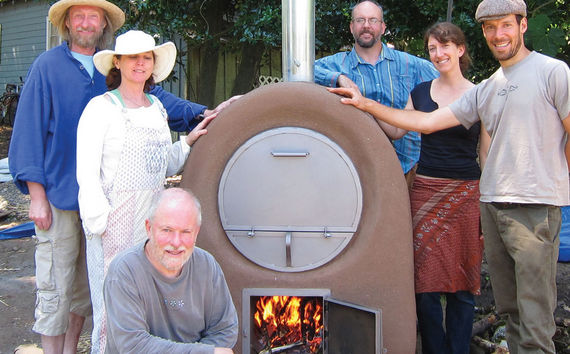A barrel oven is a versatile and highly efficient wood-fired oven that’s relatively easy to build, and easy to use. It can be the seed for a small-scale baking enterprise or the heart of a community’s wood-fired cuisine. All kinds of food can be baked in the barrel oven, including bread, roasts, pizza, cookies, cakes, pies, casseroles, and stews.
The barrel oven offers surprising convenience because it’s hot and ready to bake within 15–20 minutes of lighting a fire, unlike traditional domed or vaulted pizza ovens, which can take 2–3 hours! It’s also easy to maintain at a desired temperature for long periods of time. With its highly conductive metal barrel surrounded by a thermal mass of masonry, this type of oven is often called a “mixed oven” because it has the capability to cook with direct as well as stored heat.
The barrel oven can be built from recycled materials or brand new parts. At its center is a steel barrel, with racks inside and a door at one end. Two deep shelves offer the ability to bake eight to ten 2lb (1kg) loaves of bread, four 12″ (30cm) pizzas, or four cookie sheets at a time.
The secret to the barrel oven’s efficiency is in its construction. The firebox is located beneath the barrel. The fire hits the bottom and wraps tightly around the barrel as it travels through the carefully constructed air space between the metal barrel and the surrounding bricks. This extended contact between fire and metal concentrates the heat for cooking inside the barrel and is what allows the oven to heat up so fast.
Since ash and carbon are not introduced to the cooking chamber, it stays clean and you can use baking pans interchangeably with other ovens. The wood-fired “smoky” taste is not present in the food cooked in it.
Building a barrel oven is a manageable project for experienced builders or beginners. Once made, it becomes a gathering place for good meals and good times. Your barrel oven could easily last for many generations.
This project is adapted from Build Your Own Barrel Oven (Hand Print Press, 2012), available in print or PDF from handprintpress.com/barrel-oven.





